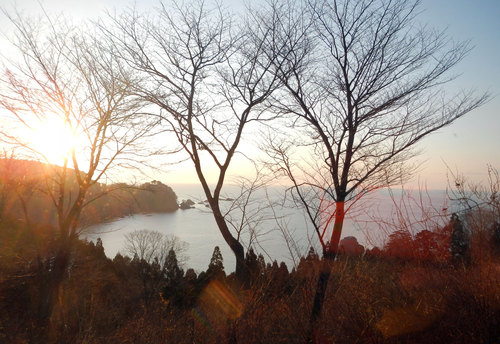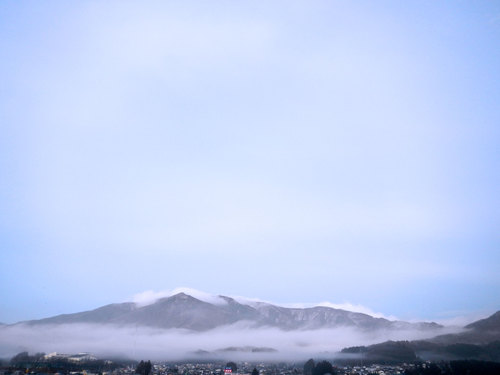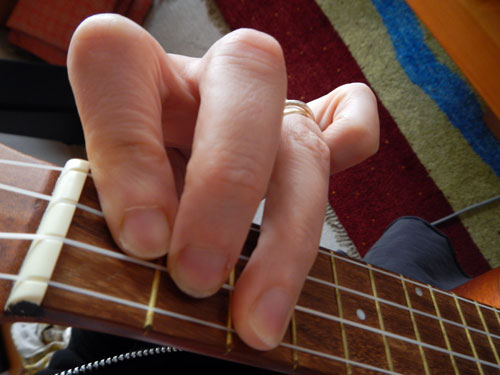Sunrise view from the cliffside cabin in Ofunato where we stayed.
I spent the past week in Iwate-ken touring schools and doing performances with Guy Totaro, the Smile Ambassador for the Tyler Foundation. We visited 11 schools in 5 days, seeing about 700 kids for play, hoop workshops, and more. It was a very satisfying experience and I've written more about the tour itself over on Spin Matsuri. This post is my personal memoranda of the trip.
The week was tremendously good, but it wasn't always easy. It was my first time to visit the area since the tsunami. What I saw was clean and under control compared to just a few months ago: the mud's been shoveled away, buildings removed and rubble reduced. As we reach the first anniversary of the disaster, there are tons of before-and-after photos out there that give the comparisons. Yet they don't tell the story in the least.
The enormity of what had happened left me stunned and withdrawn as we drove to the schools.
Huge swathes of the towns we passed through are nothing more than empty lots or bare foundations. All the private homes and smaller shops are gone. In Rikuzentakata, formerly a resort town, there are still a few larger buildings waiting to be torn down, mangled steel carcases or concrete structures with their windows busted out and grey curtains clinging to crazily bent railings. In Kamaishi, where the famed seawall failed, there is a ruined police station with a parking lot full of neatly arranged, totally crushed and rusting cars. In Kesenuma I saw one of the huge boats sitting on its keel where it came to rest inland. There is a house half submerged in the harbour at Ofunato. Some of the scenes are surreal.
Activity continues on the clearing process. There are dozens of cranes, backhoes, and workers attacking the remaining bits, sorting debris, and building fences to enclose rank after rank of leveled off piles of landfill. Except this landfill is tragic. It's people's homes, their livelihoods, everything they owned.
As we passed by one demolition site, a wine colored zabuton came tumbling down as a machine took bites from a five story apartment building. Someone sat on that cushion. I wonder how they fared? No way to know. I took a deep breath and slowly let it go before sad thoughts and tears could take hold.
There are scores of human mementos like this as you drive along. Winding through streets where there are only foundations, I spied the last remnants of a bathroom, two white ceramic bowls stacked on a low wall, the stone walkway and tiled entry to what must have been a beautiful house. It was a neighborhood; now it is nothing. So much loss everywhere.
The people who survived are beset with troubles. Many struggle with stress disorders; some mourn their personal and material losses; government-built temporary housing is sterile and isolating; neighborhood bonds are gone and never returning. The job scene has completely changed. And despite these challenges, lots of people are trying to make things ok for themselves, their families, and for their communities.
The principal at Ofunato Elementary was enthusiastic about our hoop tour and about Guy's repeat visits. Positivity seems to be his nature; he taught us some traditional clapping games that he plays with the kids and their grandparents when he hosts school events. He extends his care beyond his youthful students. I was incredibly inspired.
The vistas are remarkably beautiful.
The landscape that escaped the devastation is incredible. Mountains finger down into the ocean, creating a series of fjords. We saw gorgeous scenery as we toured. We travelled through mountains and hills, stayed on a cliffside overlooking the ocean, enjoyed forests and frozen waterfalls, and marveled over a mountain ascent that wound up a ravine through tunnels and over bridges. These moments in nature gave me respite from the overwhelming sadness of the low lying areas.
Back down in the towns, there are signs of reconstruction afoot. Cleared lots have been measured out with string and posts. I spied piles of materials and a few poured concrete footings. The government says it's ok to build in some of these places again. One of the schools we visited in its temporary quarters on a hill will be rebuilt in its old location in the tsunami plain. I don't even want to think about whether this is a good plan or a foolish one; in a town with limited land resources, perhaps it is the only possible option.
So many things I saw broke my heart. So many uneasy spirits requested my attention. So many uncertain plans hung thick in the air. It's hard to explain how visceral all of the dark and heavy energy was there, even after almost a year has passed. The devastated coastline of Tohoku is a challenging place to visit. I didn't cry until I got home.



Recent Comments